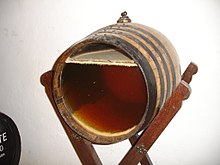Flor yeast
In winemaking, flor yeast is the yeast that sits on top of the fermenting wine with a kind of foam (the pile ) . These yeast components are lighter than wine, so they float on top and have to be able to tolerate oxygen so that they do not die .
history
Before the modern taxonomy of yeasts by Hugo Schanderl et al. the fleece cover was called "Mycoderma vini". The first comprehensive systematization of yeasts by Stelling-Dekker states:
A rigid scheme for the classification of the species cannot be given at all; the established units often merge gradually into one another.
In this context, various Saccharomyces species have been assigned to the sherrying process in the literature : s. beticus, s. cheresanus, s. cheriensis, s. oviformis and s. oxidans . In her taxonomic study from 1971 Jacomina Lodder takes the systematic view that all these yeasts are only synonyms of the species " Saccharomyces bayanus ".
process
With the non-oxidative oenological methods of winemaking that are common today , the access of air and thus the oxygen supply to the cells is suppressed in order to avoid sexual reproduction through the formation of ascospores . Different goals are pursued in the context of sherry production. The development conditions are chosen so that they come very close to those of the yeasts in their natural locations (surface of the grape ). The vegetative reproduction by sprouting leads to an aerobic fermentation .
In order to achieve a pile of yeast cover, the containers are only filled to about 80%. On the surface of the must, the yeasts initially form small islands, which then enlarge, grow together and ultimately form a coherent cell structure that can be of different thicknesses.
The main fermentation of sherry musts takes place very stormily due to the high must temperatures in the south of Spain. After the end of the main fermentation, the young wine is fortified to 15.5–16 percent by volume (→ Vino generoso ), since with a low alcohol content the alcohol would be inhaled too quickly due to strong vegetative growth. In addition to the desired yeasts, if the alcohol content is too low, the growth conditions for cream yeast and vinegar bacteria would also be favorable, which would lead to the spoilage of the wine. In the event of too strong aeration, the alcohol tolerance of the flor yeasts would reach their limits.
Due to their aerobic metabolism, the flor yeasts store significantly more fat in the cell than with anaerobic metabolism. In the surface vegetation of the pile, the fat globules even make up a significant proportion of the cell volume.
Flor yeasts play an indispensable role in all oxidative oenological processes, especially in sherry and port wines , where they have a decisive effect on flavor. The flor yeasts in the Criadera- Solera system from Jerez are extremely valuable and are preserved and protected by the small change in volume. This low throughput determines, among other things, the sales value of the product.
See also
literature
- Helmut Hans Dittrich: microbiology of wine . 1st edition. Eugen Ulmer, Stuttgart 1977, ISBN 3-8001-5807-8 .
Individual evidence
- ↑ Hugo Schanderl: The microbiological basics of winemaking and fruit processing. Ulmer Publishing House, Stuttgart, 1936
- ↑ Nellie Margaretha Stelling-Dekker: The sporogenic yeasts. Amsterdam, Holland, 1931 547 pp.
- ↑ Jacomina Lodder: The yeasts, a taxonomic study Publisher North-Holland, Amsterdam / London, 1971; today CP Kurtzman, Jack W. Fell: The Yeasts , Fifth Edition: A Taxonomic Study , Elsevier Science, April 15, 2011, ISBN 978-0444521491 .
- ^ Dittrich: Microbiology of Wine . 1977, p. 39 .
- ^ Dittrich: Microbiology of Wine . 1977, p. 193-194 .
- ^ Dittrich: Microbiology of Wine . 1977, p. 36 .
